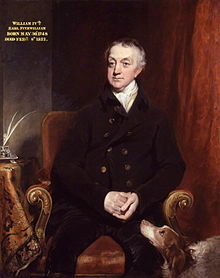Elsecar
It is thought to derive from the Old English personal name of Aelfsige (mentioned in Cartulary of Nostell Priory, 1259–66) and the Old Norse word kjarr, denoting a marsh or brushwood.[8] The village was transformed from the 1790s at the direction of the 4th Earl Fitzwilliam of Wentworth Woodhouse, with the sinking of its first deep colliery, the cutting of a canal, the building of two ironworks and associated housing designed by architect John Carr of York.A private railway station for the Earl, including a waiting room for privileged and Royal guests, was added in 1870 and now serves as a nursery for local children.[11] In 1851, Queen Victoria was taken outside the Great Exhibition, to see a column of Barnsley Seam coal which had been somehow mined intact by Elsecar miners and taken to London.During the sinking of the Elsecar New Colliery in 1795, Earl Fitzwilliam had a large atmospheric beam engine installed to pump water from deep underground.[14] In 2014, a major project was completed to rescue and conserve the engine, supported by Barnsley Council, the National Lottery Heritage Fund and Historic England.In 1799 another ironworks was founded at Milton, by the Walker Brothers of Rotherham, less than a mile to the west of Elsecar, on a hilltop in full view of the village of Wentworth just across the valley.The impressive blast wall, blowing engine house, waggon ways, ironworks reservoir and charging plateau have survived in ruinous form and plans are being made for their future conservation.Between the wars, Hoyland Nether Urban District Council created a public park to take advantage of the influx of visitors, on land granted by Earl Fitzwilliam, adding a boating jetty to the reservoir, a pavilion cafe and bandstands.[18] In March 2017 Elsecar was designated as one of ten Heritage Action Zones (HAZ) by Historic England with the benefit that the area would receive a share of £6 million.Of particular note, two major community digs, planned and carried out involving dozens of volunteers, took place on the Milton Ironworks and the New Colliery boiler house.In 2017 Caesium magnetometer, Ground Penetrating Radar (GPR) and Earth Resistance Tomography (ERT) surveys were conducted at Elsecar to attempt to determine the location of a number of former industrial buildings.[22] Elsecar has its own railway station on the Hallam and Penistone lines so it is possible to make direct journeys to Barnsley, Sheffield, Leeds, Huddersfield, and Wakefield.[26] In 1793 An Act of Parliament authorised the making of the Dearne and Dove Canal between Swinton and Barnsley, with two branches, one to Worsbrough and another to Elsecar at a location then known as Cobcar Ing.Its towpath is now part of the Trans Pennine Trail and has recently been restored and widened with funding from the South Yorkshire Mayoral Combined Authority.





South YorkshireOS grid referenceLondonMetropolitan boroughBarnsleyMetropolitan countyRegionYorkshire and the HumberCountryEnglandSovereign statePost townPostcode districtDialling codePoliceAmbulanceYorkshireUK ParliamentBarnsley EastMetropolitan Borough of BarnsleyWentworthHoylandSheffieldOld EnglishNostell PrioryOld NorseWentworth WoodhouseNewcomen steam engineWhistle Jacket4th Earl Fitzwilliamarchitect John Carr of YorkGreat ExhibitionKing George VMiners Strike of 1984-5Elsecar WorkshopsBritish CoalElsecar Heritage CentreThomas NewcomenJames WatttramroadDearne and Dove CanalChapeltownStationary enginesJohn Rennie'sMarc Isambard BrunelLeawoodHMS WarriorGreat Sheffield FloodreservoirSheffield Starrailway stationHistoric EnglandmagnetometerGround Penetrating RadarTomographybandstandgolf coursenature reserveHallamPenistoneHuddersfieldWakefieldRotherhamWoodhead LineWath marshalling yardElsecar Heritage RailwayWorsbroughTrans Pennine TrailcricketSouth Yorkshire Cricket LeagueFA CupElsecar Main F.C.George UtleyBobby KnuttListed buildings in Hoyland MiltonElsecar railway stationElsecar CollieriesNational Heritage List for EnglandYouTubeCeremonial countyCity of DoncasterMetropolitan Borough of RotherhamCity of SheffieldArmthorpeAskernBawtryBentleyConisbroughCudworthDinningtonDoncasterEdlingtonGoldthorpeHatfieldMaltbyMexboroughMosboroughRawmarshRossingtonRoystonStainforthStocksbridgeSwintonThorneTickhillWath upon DearneWombwellList of civil parishes in South YorkshireDearneLoxleyRivelinRotherPlacesPopulation of major settlementsHigh SheriffsCastlesGrade IGrade II*Scheduled monumentsPeopleMonastic housesRiversWindmillsMuseums